Optical Instruments Free Doubts and Solutions
CBSE - XII Science - Physics - Ray Optics and Optical Instruments
Optical instrument
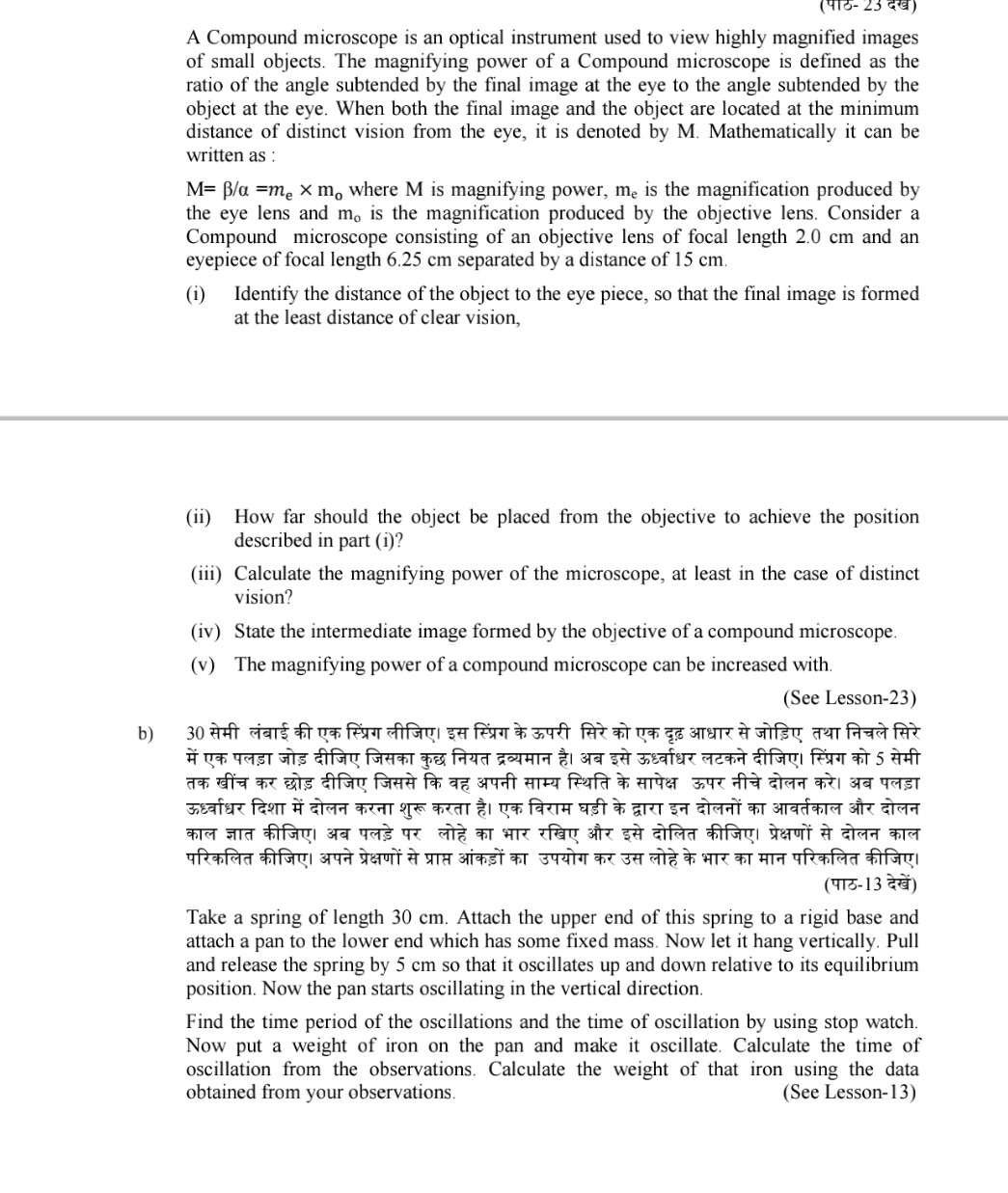
CBSE - XII Science - Physics - Ray Optics and Optical Instruments
derive the expression for the magnifying Power and the length of a compound microscope using two convex lenses.
CBSE - XII Science - Physics - Ray Optics and Optical Instruments
derive an expression for the magnifying power of an astronomical telescope in normal adjustment?
CBSE - XII Science - Physics - Ray Optics and Optical Instruments
Define and write expression for magnifying power of an astronomical telescope in normal adjustment (i,e, when the final image is formed at infinity)
CBSE - XII Science - Physics - Ray Optics and Optical Instruments
Find the maximum magnifying power of a compound microscope having a 25 diopter lens as the objective, a 5 diopter lens as the eyepiece and the separation 30 cm between the two lenses. The least distance for clear vision is 25 cm.
CBSE - XII Science - Physics - Ray Optics and Optical Instruments
the magniuifying power of a telescope is 9. when it adjusted for parallel rays the didtance b/w the eye piece and objective lens is 20cm find the focal length of both lenses
CBSE - XII Science - Physics - Ray Optics and Optical Instruments
which mirror does used in microscope and why?
CBSE - XII Science - Physics - Ray Optics and Optical Instruments
Is combination of a mirror and lens in syllabus of class 12?
CBSE - XII Science - Physics - Ray Optics and Optical Instruments
Derivation of compound microscope
CBSE - XII Science - Physics - Ray Optics and Optical Instruments
astronomical telesccope with full explaination
CBSE - XII Science - Physics - Ray Optics and Optical Instruments
A compound microscope consists of an objective of focal length 1 cm and eye piece of focal length 5 c separated by 12.2 cm. At what distance from the objective should an object be placed so that the final image is formed at least distance of distinct vision?
CBSE - XII Science - Physics - Ray Optics and Optical Instruments
A convex lens of focal length 15 cm is placed in front of a convex mirror. Both are coaxial and the lens is 5 cm from the apex of the mirror. When an object is placed on the axis at a distance of 20 cm from the lens ,it is found that the image coincides with the object. Calculate the radius of curvature of the mirror.
CBSE - XII Science - Physics - Ray Optics and Optical Instruments
discuss about the qualitative Idea resolving power of astronomical telescope
CBSE - XII Science - Physics - Ray Optics and Optical Instruments
Q no 9
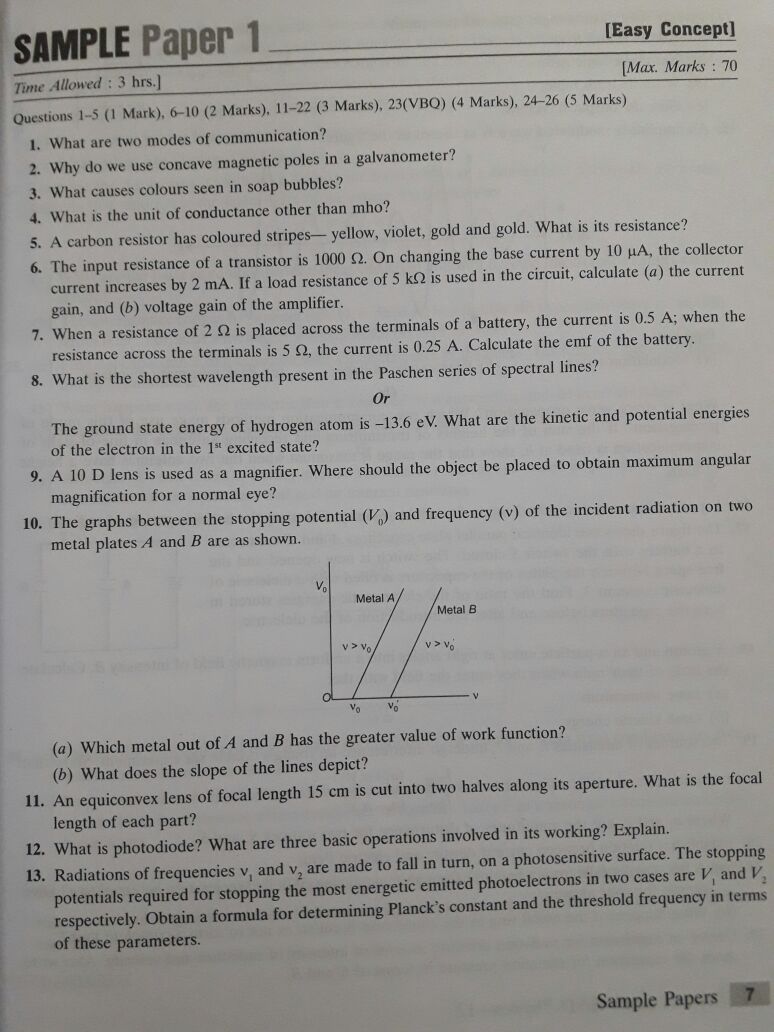

CBSE - XII Science - Physics - Ray Optics and Optical Instruments
What is a cassegrain telescope?
CBSE - XII Science - Physics - Ray Optics and Optical Instruments
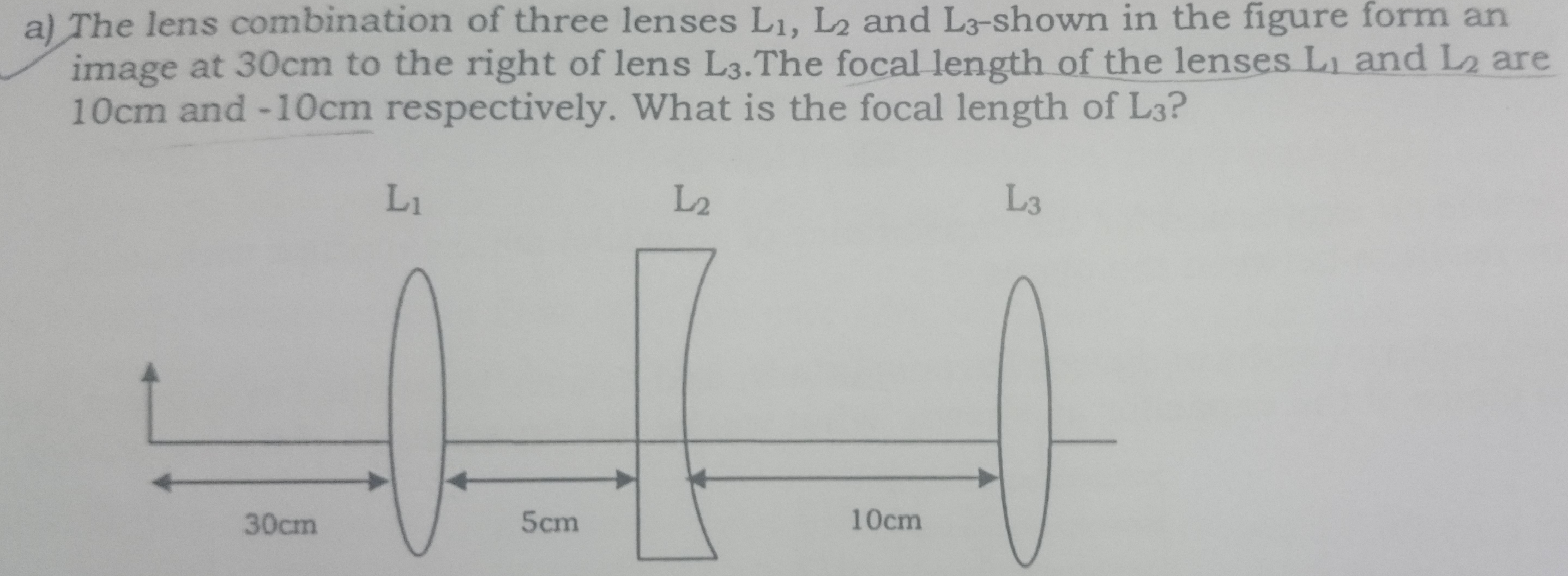
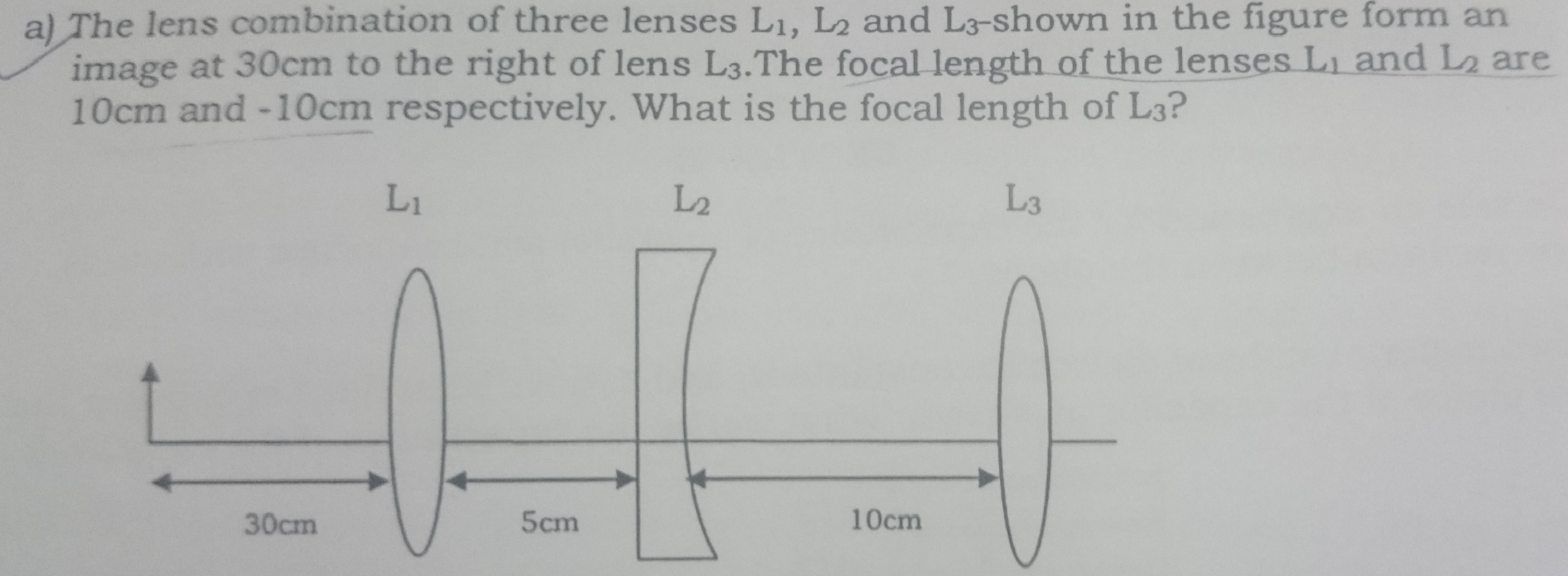 Please help me to solve this?
Please help me to solve this?

 Please help me to solve this?
Please help me to solve this?CBSE - XII Science - Physics - Ray Optics and Optical Instruments
hello teachers well this question is not related to my course m student and passionately want a cosmos telesope should you just asking should give me a telesope if i top in my board exams i promise i say eveyone one that i leared from topperlearning
i just ask its your wish teachers if you dont give me than just tell me how it made but cosmos related not ordinary i just request as a student
CBSE - XII Science - Physics - Ray Optics and Optical Instruments
EXPLAIN DOPPLER EFFECT OF LIGHT.<I'VE STUDIED ABOUT RED SHIFT ,I HAVE NOT UNDERSTOOD IT>PLEASE EXPLAIN SO THAT I HAVE NO CONFUSION LEFT.
CBSE - XII Science - Physics - Ray Optics and Optical Instruments
An angular magnification of30X is desired using objectve of focal length1.25 cm and an eye peice of focal length 5 cm. How would you set up compound icroscope
CBSE - XII Science - Physics - Ray Optics and Optical Instruments
how power and length of aperture of lens is recquired in compound microscope and telescope
CBSE - XII Science - Physics - Ray Optics and Optical Instruments
draw a ray diagram to show the image formation a compund microscope .explain briefly the working .derive an expression for its magnifying power.why the diameter of objective of microscope should be small?
CBSE - XII Science - Physics - Ray Optics and Optical Instruments
define resolving power of compound microscope .how does the resolving power of a compound change when-a refractive index of medium between the object and objective lens increases b wavelength of the light used is increased c decreasing the diameter of objective d increasing the focal length of its objective
CBSE - XII Science - Physics - Ray Optics and Optical Instruments
define the resolving power of astronomical telescope.write the expression for it and state on what factors it depends
CBSE - XII Science - Physics - Ray Optics and Optical Instruments
can you please suggest me mnimum magnification required to build a astronomical telescope? how do size of aperture play role in the factors like resolution and magnification? could you pease also suggest me recommended lenses' focal length and aperture to build a telescope?
CBSE - XII Science - Physics - Ray Optics and Optical Instruments
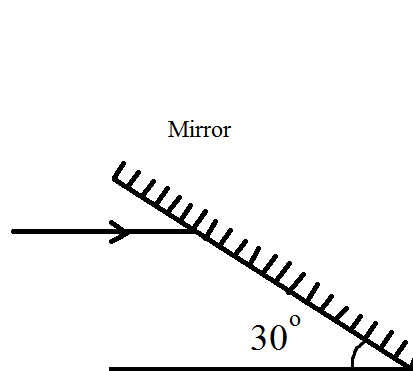 As shown above, a plane mirror is inclined at 30 degrees to horizontal and a horizontal ray is incident on it. What angle does the reflected ray make with the incident ray?
As shown above, a plane mirror is inclined at 30 degrees to horizontal and a horizontal ray is incident on it. What angle does the reflected ray make with the incident ray?

CBSE - XII Science - Physics - Ray Optics and Optical Instruments
The focal lengths of the objective and the eyepiece of a compound microscope are 4cm and 6 cm respectively. If object is placed at distance 6 cm infront of objective lens, then maximum magnification of microscope is
1.) 31/3
2.) 62/3
3.)15/3
4.)10/3
Please explain.
CBSE - XII Science - Physics - Ray Optics and Optical Instruments
suppose while sitting in a parked car you notice a jogger approaching towards you in a side view mirror of R=2m. if the jogger is running at a speed of 5m/s . how fast the iimage of the jogger appear to moove when the jogger is (a)39m (B)29m (C)19m (D)9m away.
CBSE - XII Science - Physics - Ray Optics and Optical Instruments
derivation of youngs double slit expt?????
CBSE - XII Science - Physics - Ray Optics and Optical Instruments
when is the magnification taken negative for telescope and compound microscope???
CBSE - XII Science - Physics - Ray Optics and Optical Instruments
the focal lengths of objective and eye lense of a microscope are 1.6 and 2.5 cm .the distance between the two lenses is 21.7cm.if the final image is formed at infinity the distance between the object and the objective lens is ?(ans.1.75cm)
CBSE - XII Science - Physics - Ray Optics and Optical Instruments
- the diameter of moon is 3.5
 10 3
10 3 (10 to the power 3) km and its distance from the earth is 3.8
(10 to the power 3) km and its distance from the earth is 3.8 10 5(10 to the power 5)km. it is seen by atelescope having the focal length of the objective and the eye piece as 4m and 10 cm respectively. the diameter of the image of the moon will be approximately ?(ans.20
10 5(10 to the power 5)km. it is seen by atelescope having the focal length of the objective and the eye piece as 4m and 10 cm respectively. the diameter of the image of the moon will be approximately ?(ans.20 ).
).

 10 3
10 3 (10 to the power 3) km and its distance from the earth is 3.8
(10 to the power 3) km and its distance from the earth is 3.8 10 5(10 to the power 5)km. it is seen by atelescope having the focal length of the objective and the eye piece as 4m and 10 cm respectively. the diameter of the image of the moon will be approximately ?(ans.20
10 5(10 to the power 5)km. it is seen by atelescope having the focal length of the objective and the eye piece as 4m and 10 cm respectively. the diameter of the image of the moon will be approximately ?(ans.20 ).
).

CBSE - XII Science - Physics - Ray Optics and Optical Instruments
the least resolvable angle by a telescope using objective of aperture 5 cm and light of  =4000 A
=4000 A (angestrom) is nearly? (ans. 1
(angestrom) is nearly? (ans. 1 50 sec. ) pls explain how?
50 sec. ) pls explain how?
 =4000 A
=4000 A (angestrom) is nearly? (ans. 1
(angestrom) is nearly? (ans. 1 50 sec. ) pls explain how?
50 sec. ) pls explain how? CBSE - XII Science - Physics - Ray Optics and Optical Instruments
an achromatic telescope objective is to be made by combining the lenses of flint and crown glasses. this proper choice is ?
CBSE - XII Science - Physics - Ray Optics and Optical Instruments
to remove the chromatic aberration the combination of lenses should be such that- A)Fr+Fv =0 (b) Fr>Fv (c) Fr<Fv (d.) Fr-Fv=0. [where Fr or Fv represents the equivalent focal lengths of the combination for red and violet colours.] please explain it clearly.?
CBSE - XII Science - Physics - Ray Optics and Optical Instruments
1)to remove the chromatic aberration the combination of lenses should be. whare( Fr and Fv represent the equivalent focal length of the combination for red and violet colours). 2)an achromatic telescope objective is to be made by combining the lenses of flint and crown glasses.this proper choice is (ans.convergent of crown and divergent of flint) how? pls explain it. 3)an equilateral prism is placed on the prism table of spectrometer in the position of minimum deviation .if the angle of incidence is 60 ,the angle of deviation of the ray is (ans.60
,the angle of deviation of the ray is (ans.60 )
)
 ,the angle of deviation of the ray is (ans.60
,the angle of deviation of the ray is (ans.60 )
) 
